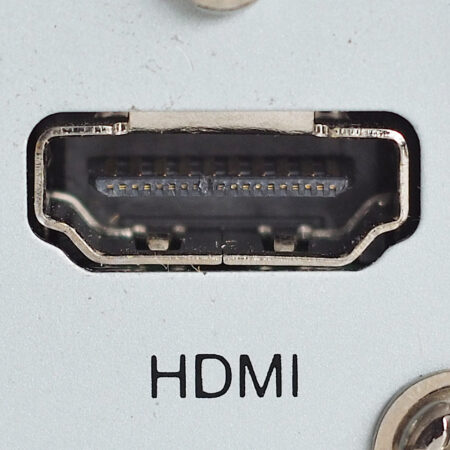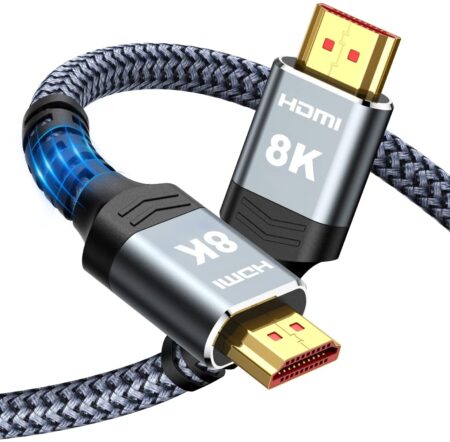Simply put, the answer to “is HDMI backward compatible?” is a resounding yes.
Both the HDMI cables and the ports are backward compatible. Hence, HDMI 2.1 is compatible with HDMI 2.0 and 1.4. Similarly, HDMI 2.0 is compatible with HDMI 1.4 and older gen interfaces.
In other words, if you have a PC with an HDMI 2.0 port, you can connect to a monitor with HDMI 1.4 port and vice versa.
Similarly, if you have an HDMI 2.0 cable, you can use it on an HDMI 1.4 TV.
I will discuss HDMI ports and cables and their versions in detail in the following.
TABLE OF CONTENTS
HDMI Ports and HDMI Cable Versions
Before we delve deeper into the topic, you must note that two components make the HDMI interface happen.
- HDMI ports
- HDMI cables.
The critical point is that the ports and the cables have different versions!
Is HDMI Backwards Compatible?
As mentioned earlier, the HDMI interface is certainly backward compatible. The port and the cable version are consistent with the older and inferior specs.
We can look at the ports and cables separately to answer this question.
Are HDMI Ports Backward Compatible?

With the resolution and refresh rate on monitors and TVs increasing, so does the bandwidth requirement for the A/V interface.
The higher the resolution and the refresh of monitors and TVs, the more data they generate, hence the more robust an HDMI interface they need.
The HDMI interface evolves with the bandwidth requirement.
HDMI 1.4, perhaps the most widespread interface, has a bandwidth of 10.2 Gbit/s. HDMI 2.0, the next iteration, has a bandwidth of 18 Gbit/s, and so on.
So basically, a device with an HDMI 1.4 port would be limited to catering to 4K@30Hz. If you want your TV or monitor to work at 4K@60Hz, you will need at least an HDMI 2.0 port.
The following table shows the different HDMI versions and the maximum specs and bandwidth they can support.
| HDMI Version | Max Resolution | Max Refresh Rate | Max Bandwidth (Gbit/s) | Effective Bandwidth (Gbit/s) | HDR? | Audio Technology Supported |
|---|---|---|---|---|---|---|
| HDMI 1.0 | 1080p | 1080p @ 60 Hz | 4.95 | 3.96 | No | – 8 Audio Channels |
| HDMI 1.1/1.2 | 1440p | 1440p @ 30 Hz | 4.95 | 3.96 | No | – 8 Audio Channels -Super Audio CDs |
| HDMI 1.3/1.4 | 4096 x 2160 (4K) | 120 Hz @ FHD Resolution 30 Hz @ 4k Resolution 24 Hz @ 4k Resolution | 10.2 | 8.16 | No | – 8 Audio Channels – ARC – Dolby TrueHD – DTS-HD |
| HDMI 2.0 | 4096 x 2160 (4K) | 60 Hz @ 4K Resolution | 18 | 14.40 | Yes | – 32 audio channels, – Dynamic Resolution Adaptation (DRA) – High-Efficiency Advanced Audio Coding (HE-AAC) |
| HDMI 2.1 | Upto 10240 x 4320 (10K) | Upto 120Hz @ 10K | 48 | 42.67 | Yes | – 32 audio channels – eARC |
The latest HDMI version is 2.1, and it can support even 10K resolution at a 120Hz refresh rate!
Hence, since newer HDMI ports can carry much more data than their older gen counterparts, it naturally makes them backward compatible.
However, there is a caveat:
The Interface Will Work at The Specs of the Weaker Device
There is a possibility that the devices in your interface do not conform to the same version.
For instance, if you have a monitor with an HDMI 2.0 that can support 4K@60Hz, but your PC only has an HDMI 1.4 port, the entire interface will be limited to the specs of HDMI 1.4, i.e., 4K@30Hz.
The same is true if you have a Set-Top box or a gaming console connected to your TV.
If you have a Sony PS5 gaming console with an HDMI 2.1, but your TV only has an HDMI 2.0 port, it will support the max specs of 4K@60Hz, despite the HDMI 2.1 on PS5 being capable of pushing 8K@60Hz.
Also Read: How to Check HDMI on Laptop?
Are HDMI Cables Backward Compatible?

As mentioned, the HDMI cable version must also be considered for your connection to work at the desired specs.
While all HDMI cables may look the same outside, their performance can differ.
The following table shows the different HDMI cables based on their performance.
| HDMI Standard Certification | Max Data Rate Supported | Specs Supported | Best Port |
|---|---|---|---|
| Standard | 4.95 Gb/s | 720 or 1080P @ 60Hz | <1.4 |
| High Speed | 10.2 Gb/s | FHD @ 60Hz QHD @ 60Hz 4K @ 30Hz | 1.4 |
| Premium High Speed | 18 Gb/s | 4k @ 60Hz | 2.0 |
| Ultra High Speed | 48 Gb/s | 4K @ 60Hz 8K @ 120Hz 10K @ 120hz | 2.1 |
Hence there are four types of HDMI cables:
- Standard HDMI, aka HDMI 1.4 cable
- High Speed aka HDMI 1.4 cable
- Premium High Speed, aka HDMI 2.0 cable
- Ultra High Speed, aka HDMI 2.1 cable
The Standard HDMI cable is more or less obsolete.
Most of the HDMI cables out there are High-Speed HDMI cables or HDMI 1.4 cables.
So just like the HDMI ports, the cables also have a limited bandwidth they can carry. An HDMI 1.4 (High-Speed HDMI cable) can take 4K@30Hz max. Whereas, if you want 4K@60Hz, you must have an HDMI 2.0 cable (Premium High-Speed Cable).
And just the like HDMI ports, the cables are also backward compatible.
Meaning an HDMI 2.0 cable can be used to connect HDMI 1.4 ports. Similarly, an HDMI 2.1 cable can connect HDMI 2.0 and 1.4 ports.
Also Read: How Many Types of HDMI Cables Are There?
FREQUENTLY ASKED QUESTIONS
1. Is HDMI 2.0 Backwards Compatible?
Yes, both the HDMI 2.0 ports and the HDMI 2.0 cables are backward compatible with HDMI 1.4 devices.
For instance, you can connect an HDMI 2.0 monitor to a laptop with an HDMI 1.4 port. But you will only be limited to the specs of HDMI 1.4 port (4K@30Hz).
The same goes for HDMI cables.
2. Is HDMI 2.1 Backwards Compatible?
Yes, HDMI 2.1 ports and cables are backward compatible with HDMI 2.0 and HDMI 1.4 specs.
In other words, you can use an HDMI 2.1 cable with HDMI 2.0 or 1.4 ports.
3. Are 4k HDMI Cables Backward Compatible?
There is a misconception that 4K HDMI cables are in a different category.
The fact of the matter is that almost all contemporary HDMI cables can carry a 4K resolution. The difference is in the refresh rate.
The short answer, though, is yes. 4K HDMI cables are backward compatible.
An HDMI 2.0 cable can display 4K@60Hz max; it is compatible with an HDMI 1.4 port.
Similarly, an HDMI 2.1 cable can display 4K@240Hz! Yet it is also compatible with devices only with HDMI 2.0 or 1.4 ports.
4. Is HDMI backwards compatible with older devices?
Yes, HDMI is generally backwards compatible with older devices, meaning that newer HDMI devices can be used with older HDMI cables and ports, and vice versa.
However, the maximum resolution and other capabilities may be limited by the capabilities of the older device.
5. How do you troubleshoot HDMI connection problems?
To troubleshoot HDMI connection problems, start by checking that the HDMI cable is securely connected to both devices and that both devices are powered on.
If that does not work, try using a different HDMI cable or connecting to a different HDMI port on the device.
You can also try resetting the devices by unplugging them from power for a few minutes and then reconnecting them.
If the issue persists, you may need to update the firmware or drivers for the devices or contact technical support for further assistance.
Also Read: Does PS5 Come with HDMI 2.1 Cable?
Final Words
TL;DR the answer to the question “is HDMI Backwards Compatible?” is a yes. Every new HDMI version is backward compatible with the previous version.
This applies to both HDMI ports and cables.
